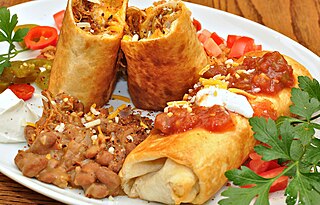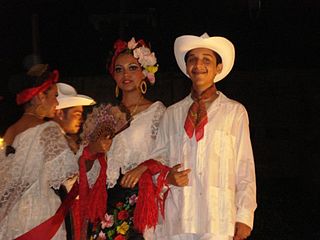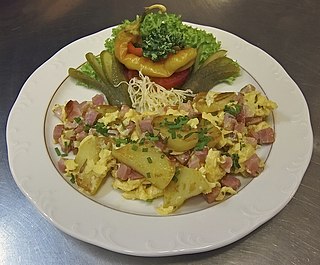
Spanish cuisine consists of the traditions and practices of Spanish cooking. It features considerable regional diversity, with important differences between the traditions of each of Spain's regional cuisines.

A taco is a traditional Mexican food consisting of a small hand-sized corn- or wheat-based tortilla topped with a filling. The tortilla is then folded around the filling and eaten by hand. A taco can be made with a variety of fillings, including beef, pork, chicken, seafood, beans, vegetables, and cheese, and garnished with various condiments, such as salsa, guacamole, or sour cream, and vegetables, such as lettuce, onion, tomatoes, and chiles. Tacos are a common form of antojitos, or Mexican street food, which have spread around the world.

An enchilada is a Mexican dish consisting of a corn tortilla rolled around a filling and covered with a savory sauce. Enchiladas can be filled with various ingredients, including meats, cheese, beans, potatoes, vegetables, or combinations. Enchilada sauces include chili-based sauces, such as salsa roja, various moles, tomatillo-based sauces, such as salsa verde, or cheese-based sauces, such as chile con queso.

Tomás de Zumalacárregui e Imaz, known among his troops as "Uncle Tomás", was a Spanish Basque officer who lead the Carlist faction as Captain general of the Army during the First Carlist War. He was occasionally nicknamed the "Wolf of the Amezcoas", making reference to his famous military victory in the region of Navarre.

In North America, a corn tortilla or just tortilla is a type of thin, unleavened flatbread, made from hominy, that is the whole kernels of maize treated with alkali to improve their nutrition in a process called nixtamalization. A simple dough made of ground, dried hominy, salt and water is then formed into flat discs and cooked on a very hot surface, generally an iron griddle called a comal.

An omelette is a dish made from eggs, fried with butter or oil in a frying pan. It is a common practice for an omelette to be folded around fillings such as chives, vegetables, mushrooms, meat, cheese, onions or some combination of the above. Whole eggs or egg whites are often beaten with a small amount of milk, cream, or water.

Potato pancakes are shallow-fried pancakes of grated or ground potato, matzo meal or flour and a binding ingredient such as egg or applesauce, often flavored with grated garlic or onion and seasonings. They may be topped with a variety of condiments, ranging from the savory, to the sweet, or they may be served plain. The dish is sometimes made from mashed potatoes to make pancake-shaped croquettes. Some variations are made with sweet potatoes.

A chimichanga is a deep-fried burrito that is common in Tex-Mex and other Southwestern U.S. cuisine. The dish is typically prepared by filling a flour tortilla with various ingredients, most commonly rice, cheese, beans, and a meat such as machaca, carne adobada, carne seca, or shredded chicken, and folding it into a rectangular package. It is then deep-fried, and can be accompanied by salsa, guacamole, or sour cream.

Torta is a culinary term that can, depending on the cuisine, refer to cakes, pies, flatbreads, sandwiches, or omelettes.

Jamón is a type of dry-cured ham produced in Spain. It is one of the most globally recognized food items of Spanish cuisine. It is also regularly a component of tapas.

Escabeche is the name for several dishes in Spanish, Portuguese, Filipino and Latin American cuisines, consisting of marinated fish, meat or vegetables, cooked or pickled in an acidic sauce, and flavored with paprika, citrus, and other spices.
Portuguese and Spanish, although closely related Romance languages, differ in many aspects of their phonology, grammar, and lexicon. Both belong to a subset of the Romance languages known as West Iberian Romance, which also includes several other languages or dialects with fewer speakers, all of which are mutually intelligible to some degree. A 1949 study by Italian-American linguist Mario Pei, analyzing the degree of difference from a language's parent by comparing phonology, inflection, syntax, vocabulary, and intonation, indicated the following percentages : In the case of Spanish it was 20%, the third closest Romance language to Latin, only behind Sardinian and Italian. Portuguese was 31%, making it the second furthest language from Latin after French.

In Mexican Spanish, Jarocho is a colloquial demonym for residents of the State of Veracruz, Mexico, as well as an appellative term for anything related to said state.

A flour tortilla or wheat tortilla is a type of soft, thin flatbread made from finely ground wheat flour. Made with flour- and water-based dough, it is pressed and cooked, similar to corn tortillas. The simplest recipes use only flour, water, fat, and salt, but commercially-made flour tortillas generally contain chemical leavening agents such as baking powder, and other ingredients.

Mazamorra or masamorra is the name for numerous traditional dishes from the Iberian Peninsula and Hispanic America.

Bauernfrühstück is a warm German dish made from fried potatoes, eggs, green onions, parsley, and bacon or ham. Despite its name, it is eaten not only for breakfast but also for lunch and dinner.

A Charanga is a small amateur marching band with wind and percussion instruments that plays festivals mainly in Northern Spain, Castilla-La Mancha, Castilla y León and the Valencian Community. In the past, the name charanga also applied to certain military musical bands of the Spanish Army and as ship's company bands in the Spanish Navy.

The cierzo is a strong, dry and usually cold wind that blows from the North or Northwest through the regions of Aragon, La Rioja and Navarra in the Ebro valley in Spain. It takes place when there is an anticyclone in the Bay of Biscay and a low-pressure area in the Mediterranean Sea.

Pasta frola or pasta frolla is a type of sweet tart common to Italy, Argentina, Paraguay, Uruguay, Egypt and Greece. It is a covered, jam-filled shortcrust pastry dish principally made from flour, sugar and egg. Common fillings include quince cheese, dulce de batata, dulce de leche, guava, or strawberry jam. The covering of the tart is a thin-striped lattice which displays the filling beneath in rhomboidal or square sections. Pastafrola is most usually oven-baked in a circular shape. Most of the Greek versions of this dish are filled with sweet jam: it is considered a morning dessert.

A corrala is a type of housing found in old Madrid. Sometimes, it may be called a corridor house due to blocks having doors located on corridors. Usually, it is wooden and the units look at the central area, or a patio.

























